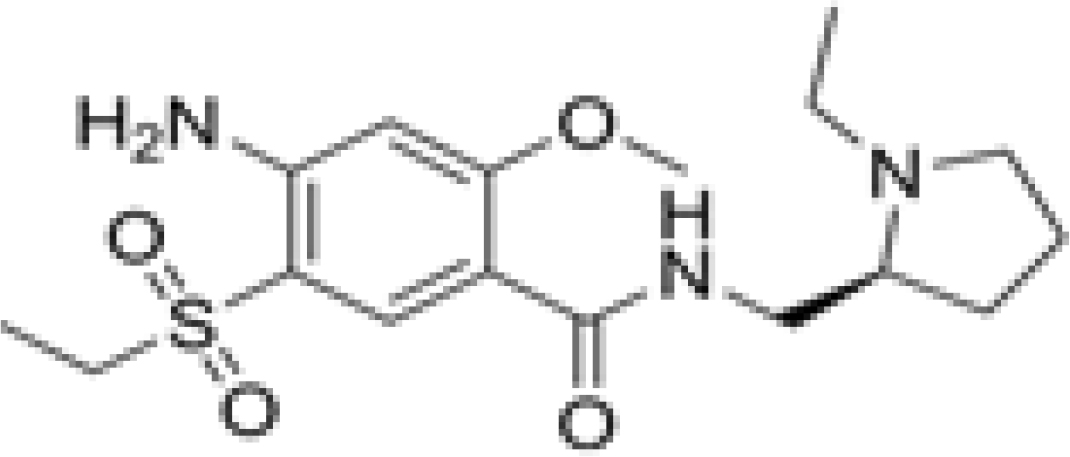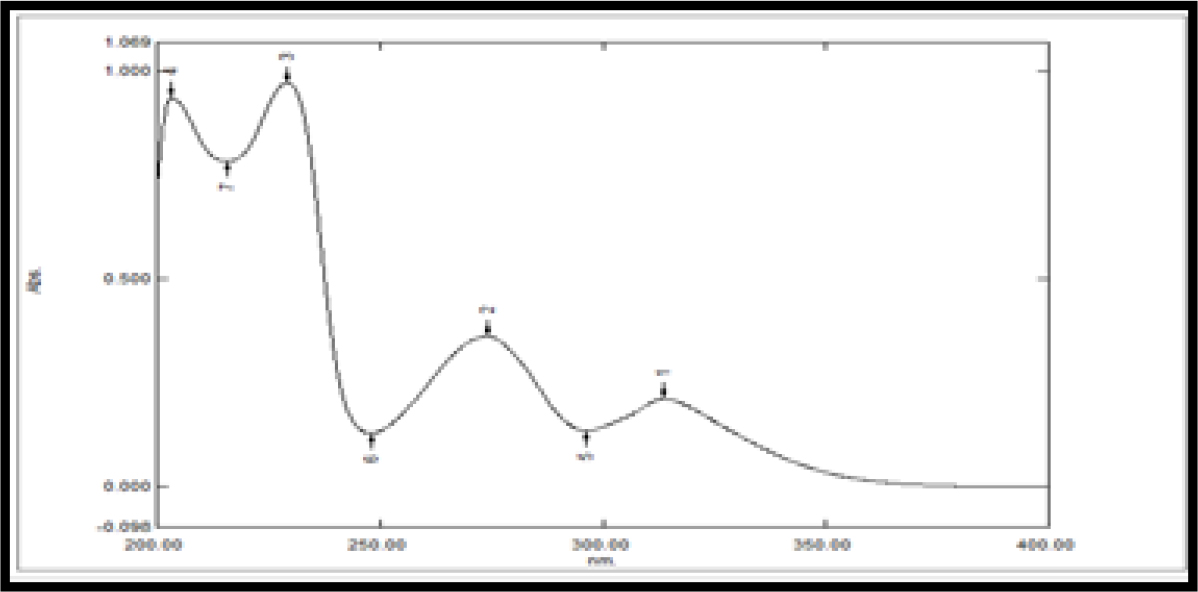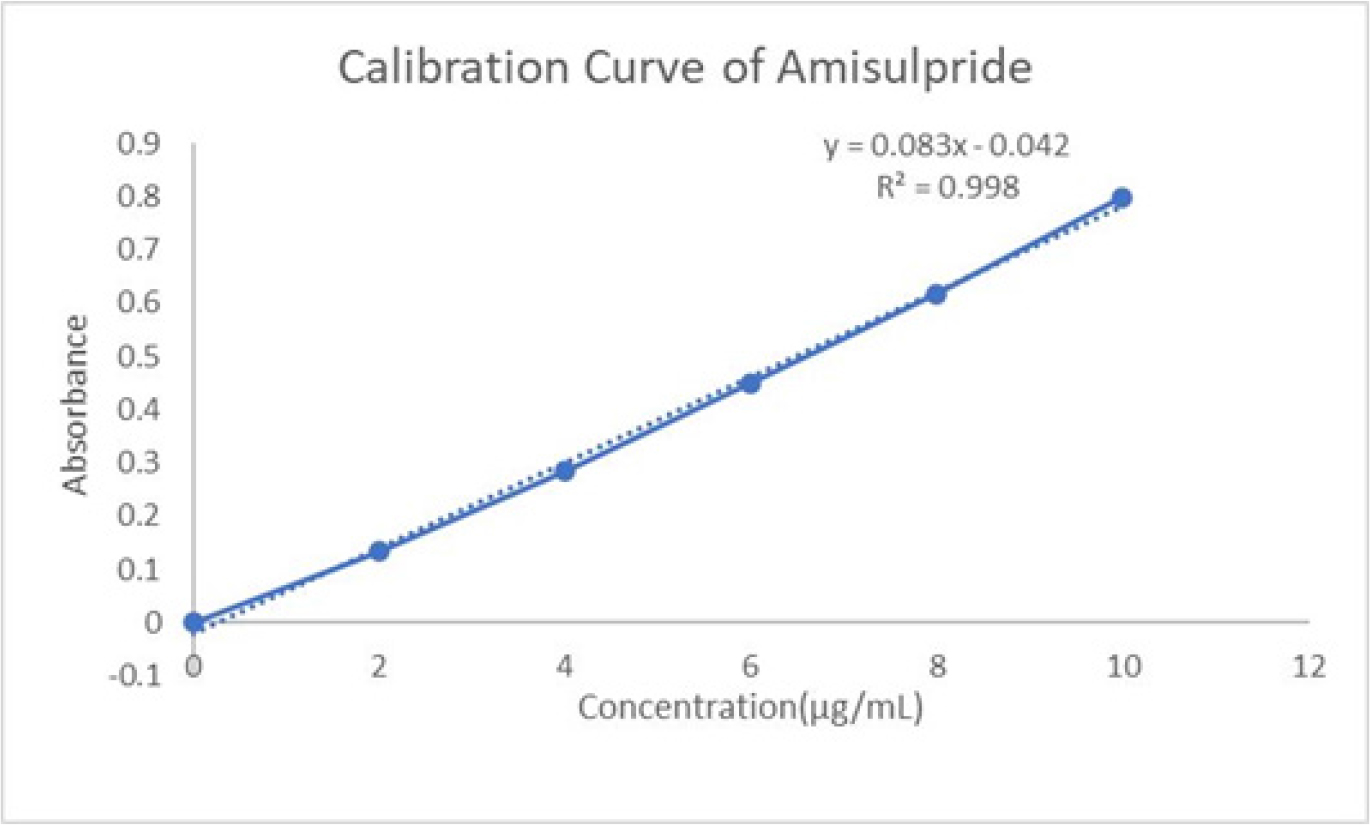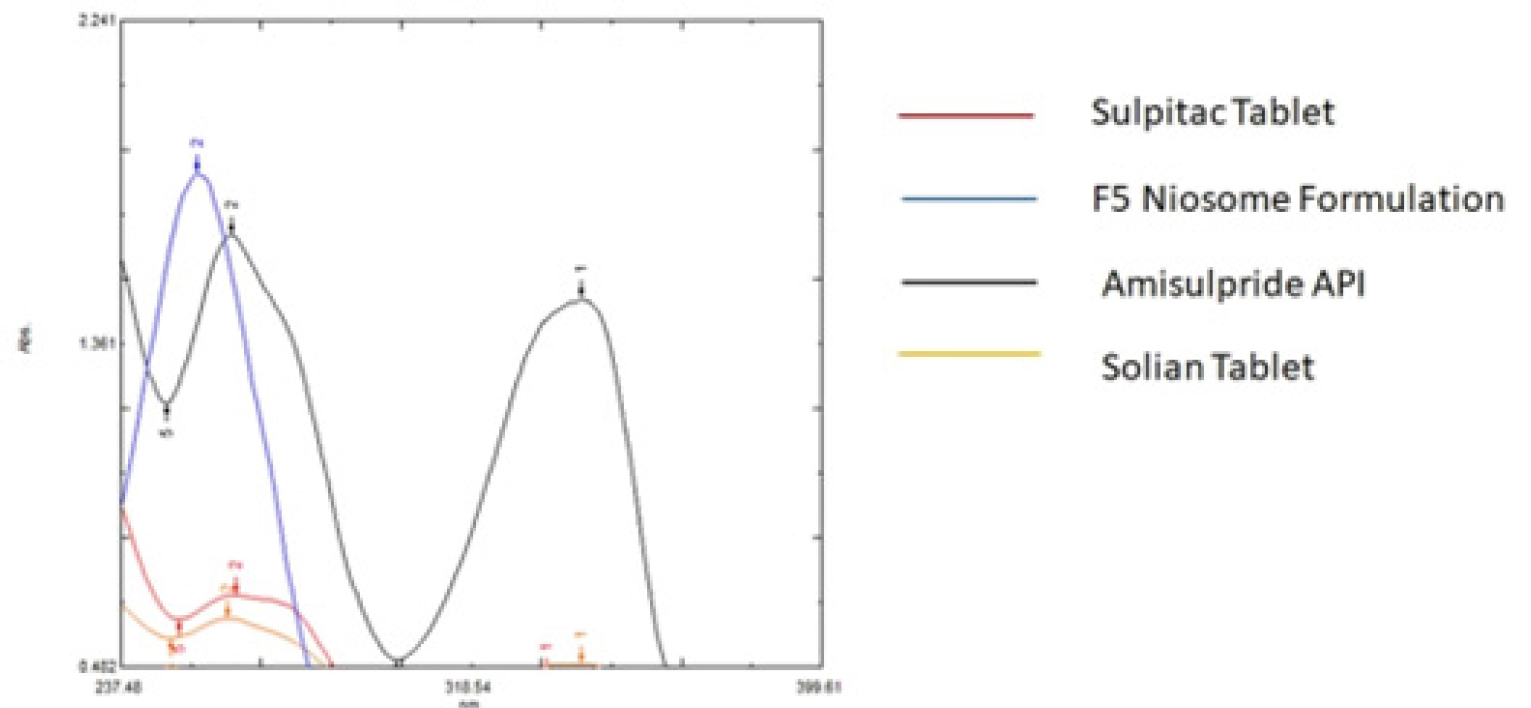ABSTRACT
Background
Schizophrenia is a persistent neuropsychiatric condition that requires precise drug delivery to the brain for effective treatment. Amisulpride, a second-generation antipsychotic, has low oral bioavailability and struggles to cross the blood–brain barrier, thus requiring innovative formulation techniques and dependable analytical methods. The aim of the proposed research work was to develop and validate an eco-friendly UV spectroscopy for measuring amisulpride in bulk drugs, niosomal formulations, and commercial products, promoting sustainable pharmaceutical quality control.
Materials and Methods
A UV spectrophotometric approach was developed using a methanol: water (77:23) solvent mixture, with detection at 280 nm. Validation followed ICH Q2 (R1) guidelines, evaluating linearity, precision, accuracy, robustness, ruggedness, LOD, and LOQ. Amisulpride-loaded niosomes were formulated by the ethanol injection method using Span-60 and cholesterol. Particle size and Zeta potential were analyzed by Malvern Zetasizer.
Results
The method showed excellent linearity (r² = 0.998), precision (%RSD < 2%), and recovery rates (97–101.3%). LOD and LOQ were found to be 0.58 µg/mL and 1.2 µg/mL, respectively. Niosomes had a particle size of 200.89 nm and a zeta potential of –23.6 mV. This method effectively detected amisulpride in the various formulations.
Conclusion
The validated UV method provides a precise, robust, and sustainable alternative to chromatographic techniques, facilitating the routine quality evaluation of amisulpride in advanced nanoformulations.
INTRODUCTION
Schizophrenia is a long-term and serious mental disorder that affects an individual’s thoughts, emotions, and behaviours. Affected individuals often appear detached from reality and exhibit reduced involvement in everyday tasks. It presents with positive symptoms, such as hallucinations and delusions, negative symptoms, such as emotional disturbances, and cognitive challenges in mental functioning (Aubel, 2021). Globally, approximately 21 million people suffer from schizophrenia, with 12 million males and 9 million females affected (Chaudhariet al., 2024).
Amisulpride (Figure 1) belongs to the second generation of antipsychotics with the molecular name 4-amino-n-((1-ethyl-2-pyrrolidinyl)methyl)-5-(ethylsulfonyl)-2-methoxybenzam, and a new atypical antipsychotic drug has demonstrated efficacy in addressing both the positive and negative symptoms of schizophrenia. Owing to its interaction with two central nervous system receptors, dopamine (D2) and serotonin (5-HT2A), it can be used to treat schizophrenia.

Figure 1:
Chemical Structure of Amisulpride.
Compared with typical antipsychotic drugs, it exhibits a lower occurrence of extrapyramidal side effects and is better tolerated. At present, Amisulpride is widely utilized for the management of various forms of schizophrenia (Abdelbary & AbouGhaly, 2015; Purushottam Agrawalet al., 2020; Telange et al., 2016) .
Amisulpride is formulated into niosomes to enhance its delivery to the brain for schizophrenia treatment. Oral administration is associated with poor solubility and limited blood–brain barrier permeability, resulting in low cerebral bioavailability. Niosomes composed of nonionic surfactants improve drug encapsulation and stability. Intranasal delivery enables direct nose-to-brain transport via the olfactory and trigeminal pathways, thereby bypassing the blood–brain barrier. This targeted approach enhances brain uptake, reduces systemic exposure, and supports sustained release, ultimately improving the therapeutic efficacy (Patilet al., 2023).
Pharmaceuticals hold a crucial and progressively important position throughout the entire progression of drug development (Mortimer, 2004). As the importance of amisulpride continues to expand in the management of psychiatric disorders, there is an increasing demand for convenient and rapid approaches to continuously evaluate and guarantee the quality of available formulations in the market (Behera, 2012).
A literature survey reveals that there is a limited UV spectroscopy method for quantifying amisulpride in bulk, nanoformulation, and marketed formulations.
The present study aimed to develop and validate a UV spectrophotometric method, which is simple, accurate, highly efficient, and repeatable for analyzing amisulpride in bulk, nano formulation, and marketed tablets.
MATERIALS AND METHODS
Materials
Amisulpride was provided as a gift sample from Symed Laboratories, Hyderabad. The reagents and chemicals used in the analysis were obtained from KLE College of Pharmacy, KAHER, Belagavi, and they were of pure and high analytical quality. For the analysis, a Shimadzu UV-Spectrophotometer, model UV-1900, equipped with UV probe software was employed. The drug sample was weighed using a calibrated weighing balance during the investigation.
Method Development
Amisulpride was quantified using a Shimadzu UV-1900 spectrophotometer equipped with UV-Probe software, utilizing a solvent mixture of methanol and water in a 77:23 ratio, with a detection wavelength at 280 nm. The method was validated in accordance with ICH Q2(R1) guidelines, evaluating parameters such as linearity (ranging from 2 to 10 µg/mL), precision (across six replicates), accuracy (at recovery levels of 50%, 100%, and 150%), ruggedness, robustness, and the Limits of Detection (LOD) and Quantification (LOQ). Niosomes were prepared by ethanol injection using Span-60 and cholesterol, and their particle size, zeta potential, and morphology were assessed using dynamic light scattering and Transmission Electron Microscopy (TEM). Statistical analysis involved calculations of %RSD, regression coefficients, and standard deviation-based determinations of LOD and LOQ.
Method Validation
To authenticate the newly formulated method parameters in accordance with the ICH guidelines (specifically, ICH guidance Q2A and Q2B), a validation process was pursued (El Assasyet al., 2019). Validation refers to the process outlined by (ICH). It involves obtaining documented evidence to ensure a high level of confidence in the consistent production of a desired outcome of readings that meet predetermined specifications and quality standards. The method validation procedure involved the assessment of the following parameters (Humaira & Dey, 2008).
Preparation of the standard solution
Selection of wavelength
The analyte’s identity was assessed by examining a 10 µg/mL concentration of the respective stock solution within the spectral range of 400 to 200 nm for Amisulpride using a methanol-water mixture (77:23 v/v).
Specificity and selectivity
Accurately measuring Amisulpride in bulk, niosome, and commercial formulations is essential. These factors were assessed to ensure that there was no interference from excipients or other external substances. The absence of absorbance at 280 nm in blank samples confirmed the method’s specificity and selectivity.
Linearity and range
Linearity was assessed by analysing amisulpride dilutions (2-10 µg/mL) at 280 nm. This process was repeated three times to ensure its consistency.
Limit of Detection and Limit of Quantification
The Detection Limit (LOD) is the smallest quantity of analyte in a sample that can be detected. The Quantification Limit (LOQ) is the minimum concentration of the analyte within a sample that can be properly and precisely quantified (Manojaet al., 2012).
The LOD and LOQ were calculated using the following set of equations: LOD = 3.3 SD of the y-intercept divided by the slope of the calibration curve and LOQ = 10 times SD of the y-intercept divided by the slope of the calibration curve(Papoutsiset al., 2014) .
LOD = 3.3 regression standard deviation/ Slope.
LOQ = 10 regression standard deviation/ Slope.
Precision
Precision tests were performed to determine the reliability of the proposed analytical approach. Six duplicates at a concentration of 4 µg/mL were analysed for repeatability. Absorbance was measured on the same day to ensure intraday accuracy. Precision analysis involved preparing a 4 µg/mL drug solution and testing it at three-time intervals during the day to assess inter-day precision. This technique was performed for three separate days to compute the percentage Relative Standard Deviation (RSD) as a measure of accuracy (Sharmaet al., 2010; Naiket al., 2025).
The method’s ruggedness and robustness were validated through systematic absorbance measurements of amisulpride at 280 nm. Ruggedness was confirmed by testing across different analysts and UV spectrophotometers, showing consistent results via mean, standard deviation, and %RSD. Robustness was demonstrated by slightly altering the detector wavelength (+2 nm) and analyzing the statistical consistency of the absorbance data, affirming the method’s reliability under minor, intentional variations in analytical conditions (Kochlinget al., 2016).
Accuracy
Formulation of Amisulpride-loaded niosomal formulation
Amisulpride-loaded Niosomes (AMSNs) were developed using the ethanol injection method. Span-60, cholesterol, and amisulpride (50 mg) were precisely weighed and dissolved in 10 mL of ethanol by bath sonication at approximately 60°C. At the same temperature, the clear organic solution was promptly transferred into a water solution, which was vigorously agitated with a Teflon-coated bead at 500 revolutions per minute (Remi magnetic stirrer). The aqueous solution immediately changed to a milky solution, indicating niosome production. To evaporate ethanol, the resultant solution was vacuumed for 15 min and agitated for an hour. Finally, the volume of the niosomal dispersion was adjusted to 30 ml by adding water (Patilet al., 2023).
Characterization of Niosomes
Vesicle Size Analysis
Amisulpride-loaded niosomes were physicochemically characterized to determine their average particle size, polydispersity index, and zeta potential. This assessment was performed using a Zetasizer (Malvern Instruments, Malvern, UK). The niosomal dispersion was appropriately diluted in distilled water (1:10) for the measurements. Folded capillary cells (DTS 1060) were used, and all measurements were performed at 25 °C. The measurements were repeated three times to ensure accuracy (Sitaet al., 2020).
Transmission Electron Microscopy (TEM) Analysis
The morphology and surface characteristics of the niosomes were assessed using high-resolution Transmission Electron Microscopy (TEM) at DST-SAIF, Cochin. A small volume of the amisulpride-loaded niosomal formulation was placed on a carbon-coated copper grid, and the sample was analyzed using TEM (Swartz & Krull, 2018).
RESULTS
The proposed UV Spectrophotometric technique offers an accurate, cost-effective, and convenient approach for amisulpride analysis. This approach underwent thorough validation following ICH Q2 (R1) guidelines, confirming its dependability, precision, and adherence to regulatory standards.
Determination of maximum wavelength
The highest absorbance in a methanol/water mixture (77:23) was found at a wavelength of 280 nm (Figure 2).

Figure 2:
UV-spectrum of amisulpride in methanol and water (77:23).
Standard calibration curve
The calibration plot for amisulpride was linear with a coefficient of correlation of 0.998 (Figure 3).

Figure 3:
Standard calibration curve for Amisulpride.
Linearity
Linearity was assessed by analysing amisulpride dilutions (2-10 µg/mL) at 280 nm; the correlation coefficient (r2) confirmed the linearity of the calibration curves. The correlation coefficient for amisulpride was 0.998.
Detection Limit and Quantification Limit
LOD and LOQ were observed to be 0.58 μg/mL and 1.2 μg/mL, respectively.
Precision
Intraday and interday experiments were conducted on separate days, and the results indicated minimal differences between them. This result suggests that the proposed methodology is consistent and reliable. The precision results, along with the relative variance calculations, are presented in Tables 1 and 2, respectively (Ramanet al., 2015).
| Concentration (μg/mL) | Absorbance 1 (11:00 am) | Absorbance 2 (1:00 pm) | Absorbance 3 (3:00 pm) | Average %RSD |
|---|---|---|---|---|
| 4 | 0.280 | 0.283 | 0.284 | 1.398 |
| 4 | 0.282 | 0.285 | 0.284 | |
| 4 | 0.277 | 0.279 | 0.276 | |
| 4 | 0.280 | 0.282 | 0.283 | |
| 4 | 0.284 | 0.286 | 0.289 | |
| 4 | 0.277 | 0.275 | 0.277 |
| Concentration (μg/mL) | Absorbance 1 (day 1) | Absorbance 2 (day 2) | Absorbance 3 (day 3) | Average %RSD |
|---|---|---|---|---|
| 4 | 0.291 | 0.278 | 0.279 | 0.9422 |
| 4 | 0.281 | 0.282 | 0.282 | |
| 4 | 0.279 | 0.279 | 0.280 | |
| 4 | 0.283 | 0.284 | 0.284 | |
| 4 | 0.278 | 0.280 | 0.282 | |
| 4 | 0.282 | 0.275 | 0.276 |
Ruggedness was assessed by performing the assay under the same conditions on different days using different analysers, with different tools, and at different times. The test results consistently fell within the range of 99-101%, indicating the robustness of the method. The robustness was further confirmed by performing the assay at different wavelengths. The Relative Standard Deviation (%RSD) was below 2%, which was well within the specified limit, as shown in Table 3 (Rathod & Desai, 2015).
| Concentration (µg/mL) | Absorbance | RSD | ||
|---|---|---|---|---|
| Analyst-1& 280nm. | Average=0.281 SD=0.0026 % RSD = 0.931 | |||
| 4 | 0.277 | |||
| 4 | 0.281 | |||
| 4 | 0.279 | |||
| 4 | 0.284 | |||
| 4 | 0.282 | |||
| 4 | 0.283 | |||
| Concentration (µg/mL) | Absorbance | RSD | ||
| Analyst-2 & 282nm. | ||||
| 4 | 0.281 | Average=0.281 SD=0.0023 %RSD=0.82 | ||
| 4 | 0.278 | |||
| 4 | 0.282 | |||
| 4 | 0.279 | |||
| 4 | 0.284 | |||
| 4 | 0.281 | |||
| %RSD | 0.82 | 0.931 | ||
Accuracy
The accuracy of the proposed method was verified using the classical addition method, recovering in the range of 97-101.30% (Rapalliet al., 2020). The results are depicted in Table 4.
| Label claim | Theoretical Value | Level addition | Amount of drug added | Average % recovery |
|---|---|---|---|---|
| 1 | 1.5 | 50% | 1.523 | 101.5333 |
| 1 | 2 | 100% | 2.0189 | 100.945 |
| 1 | 2.5 | 150% | 2.439 | 97.56 |
Solvent and standard stock solution stability
The stability of amisulpride in the solution was evaluated by calculating the Relative Standard Deviation (% RSD) of the absorbance values obtained from both freshly prepared solutions and previously prepared solutions containing amisulpride. Upon evaluation, the analytical results were found to be within acceptable limits, confirming the stability of the standard stock solution. The investigation on solution stability spanned a period of four days, (Skibińskiet al., 2007).
Characterization of Niosomal Dispersion
The zeta potential of apremilast niosomes was determined to be -23.6 mV, with a particle size of 200.89 nm. TEM confirms smooth, oval-shaped particles
Quantification of amisulpride in different marketed formulations and prepared Niosomal Formulation
Amisulpride was quantified in bulk, in various marketed products, such as Solian tablet and Sulpitac tablet, along with the Niosomal formulations. (Senet al., 2016). The formulations showed a spectrum at a wavelength of approximately 277 nm, which was close to the observed absorption maxima of amisulpride. The corresponding peaks in the spectrum can be attributed to the different excipients used in the formulations (Figure 4).

Figure 4:
UV Spectrum of marketed products and Niosomal Formulation of Amisulpride.
DISCUSSION
The developed UV spectrophotometric method represents a distinct advancement in the quantitative analysis of amisulpride, combining simplicity, sensitivity, and environmental sustainability. Unlike earlier methods such as that of (Humaira & Dey, 2008), which utilized 0.1 N HCl at 226.5 nm and risked analyte instability, the present approach employs a methanol:water system at 280 nm, optimizing excipient transparency and reducing instrument corrosion. While visible spectrophotometric methods reported by (venumadhav, 2010) and (Rao, n.d.) achieved high linearity (0.9995–0.9999) through diazotization reactions, their reliance on toxic reagents and multistep procedures made them inconsistent with green analytical chemistry principles. The newly developed method addresses these limitations through a non-toxic and cost-efficient solvent system that achieves superior LOD (0.58 µg/mL) and LOQ (1.2 µg/mL) values, thereby enabling sensitive and reliable quantification. As the first validated UV spectrophotometric method for amisulpride-loaded niosomes, it supports advanced formulation studies while maintaining compliance with ICH Q2(R1) guidelines. Demonstrating excellent linearity (r² = 0.998), precision (%RSD < 2%), and recovery (97–101.3%), the method achieves HPLC-comparable accuracy with minimal infrastructure requirements, making it suitable for routine quality control in resource-limited environments. Robustness and ruggedness evaluations confirmed reproducibility across analysts and wavelengths. The optimized niosomal formulation exhibited a mean particle size of 200.89 nm and a zeta potential of -23.6 mV, indicative of colloidal stability favorable for intranasal delivery in schizophrenia treatment. Overall, this eco-friendly and reproducible UV spectrophotometric approach provides a sustainable, practical, and analytically sound alternative for the quantification of amisulpride in bulk, niosomal, and commercial formulations.
CONCLUSION
A validated UV spectrophotometric method was successfully developed for precise quantification of amisulpride in bulk, niosomal, and commercial formulations. Demonstrating excellent linearity, precision, and accuracy with recovery rates of 97–101.3%, this eco-sustainable approach offers a cost-effective alternative to chromatographic techniques, aligning with ICH Q2 (R1) standards. The formulated niosomes exhibited optimal colloidal stability (particle size: 200.89 nm, zeta potential: –23.6 mV), supporting effective intranasal brain delivery for schizophrenia therapeutics.
Cite this article:
Sutar KP, Shashtri U, Patil V, Lad AM, Araga NA, Wakkundmath G. A Novel Sustainable UV Spectrophotometric Approach for the Quantification of Amisulpride in Bulk and Nanoformulations. J Young Pharm. 2025;17(4):902-8.
ACKNOWLEDGEMENT
The authors are thankful to KLE College of Pharmacy, Belagavi for their support in carrying out this research work.
ABBREVIATIONS
| API | Active Pharmaceutical Ingredient |
|---|---|
| UV Spectroscopy | Ultraviolet Spectroscopy |
| ICH | International Conference on Harmonisation |
| LOD | Limit of Detection |
| LOQ | Limit of Quantification |
| HPLC | High Performance Liquid Chromatography |
| PDI | Polydispersity Index |
| TEM | Transmission electron microscopy |
| RSD | Relative standard deviation. |
References
- Abdelbary A. A., AbouGhaly M. H. H.. (2015) Design and optimization of topical methotrexate loaded niosomes for enhanced management of psoriasis: Application of Box–Behnken design, in vitro evaluation and in vivo skin deposition study. International Journal of Pharmaceutics 485: 235-243 https://doi.org/10.1016/j.ijpharm.2015.03.020 | Google Scholar
- Aubel T.. (2021) Cariprazine: Patients with Treatment-Resistant Schizophrenia. Neuropsychiatric Disease and Treatment Volume 17: 2327-2332 https://doi.org/10.2147/NDT.S315653 | Google Scholar
- Behera S.. (2012) UV-Visible Spectrophotometric Method Development and Validation of Assay of Paracetamol Tablet Formulation. Journal of Analytical & Bioanalytical Techniques 03 https://doi.org/10.4172/2155-9872.1000151 | Google Scholar
- Chaudhari K. S., Dhapkas M. P., Kumar A., Ingle R. G.. (2024) Mental Disorders – A Serious Global Concern that Needs to Address. International journal of pharmaceutical quality assurance 15: 973-978 https://doi.org/10.25258/ijpqa.15.2.66 | Google Scholar
- El Assasy A. E.-H. I., Younes N. F., Makhlouf A. I. A.. (2019) Enhanced Oral Absorption of Amisulpride Via a Nanostructured Lipid Carrier-Based Capsules: Development, Optimization Applying the Desirability Function Approach and In Vivo Pharmacokinetic Study. AAPS PharmSciTech 20: 82 https://doi.org/10.1208/s12249-018-1283-x | Google Scholar
- Gschwend M. H., Arnold P., Ring J., Martin W.. (2006) Selective and sensitive determination of amisulpride in human plasma by liquid chromatography–tandem mass spectrometry with positive electrospray ionisation and multiple reaction monitoring. Journal of Chromatography B 831: 132-139 https://doi.org/10.1016/j.jchromb.2005.11.042 | Google Scholar
- Humaira S, Dey A.. Int. J. chem. sci. 2008;6(1):437-440. Development and validation of spectrophotometric method for determination of amisulpride in pharmaceutical dosage forms.
- Khan M. F., Rita S. A., Kayser M. S., Islam M. S., Asad S., Rashid R. Bin, Bari M. A., Rahman M. M., Al Aman D. A. A., Setu N. I., Banoo R., Rashid M. A., et al. (2017) Theoretically guided analytical method development and validation for the estimation of rifampicin in a mixture of isoniazid and pyrazinamide by UV spectrophotometer. Frontiers in Chemistry 5 https://doi.org/10.3389/fchem.2017.00027 | Google Scholar
- Kochling J., Wu W., Hua Y., Guan Q., Castaneda-Merced J.. (2016) A platform analytical quality by design (AQbD) approach for multiple UHPLC-UV and UHPLC–MS methods development for protein analysis. Journal of Pharmaceutical and Biomedical Analysis 125: 130-139 https://doi.org/10.1016/j.jpba.2016.03.031 | Google Scholar
- Manoja K. M. L., Gurupadayya B. M., Srujana S., Raaga L. V., Chandan R. S.. (2012) Development and validation of stability stability-indicating RP-HPLC method for amisulpride in bulk and pharmaceutical formulation. Indian drugs 49: 43-50 https://doi.org/10.53879/id.49.04.p0043 | Google Scholar
- Mortimer A. M.. (2004) How do we choose between atypical antipsychotics? The advantages of amisulpride. The International Journal of Neuropsychopharmacology 7: S21-S25 https://doi.org/10.1017/S1461145704004134 | Google Scholar
- Naik S. S., Sutar K. P., Sequeira A. W., Jadhav A. D., Jadhav S. J.. (2025) UV- Method Development for Quantifying 3-Acetyl-11-Keto-Beta-Boswellic Acid in Bulk and Topical Nanoformulation. Research Journal of Pharmacy and Technology : 2493-2500 https://doi.org/10.52711/0974-360X.2025.00356 | Google Scholar
- Papoutsis I., Rizopoulou A., Nikolaou P., Pistos C., Spiliopoulou C., Athanaselis S., et al. (2014) A validated GC/MS method for the determination of amisulpride in whole blood. Journal of Chromatography B 947–948: 111-116 https://doi.org/10.1016/j.jchromb.2013.12.024 | Google Scholar
- Patil V. S., Sutar K. P., Pockle R. D., Usulkar S., Jadhav V. A.. (2023) Formulation, Optimization and Evaluation of amisulpride-loaded Niosomal Intranasal Gel for Brain Targeting. Therapeutic Delivery 14: 635-647 https://doi.org/10.4155/tde-2023-0059 | Google Scholar
- Purushottam Agrawal Y., Agrawal M. Y., Jadhav S. B., Shinde R. J.. (2020) Development and Validation of Novel UV Spectrophotometric Method for the Determination of Evogliptin Tartarate in Pharmaceutical Dosage Form. Indian Journal of Pharmaceutical Education and Research 54: 1174-1179 https://doi.org/10.5530/ijper.54.4.214 | Google Scholar
- Raman N. V. V. S. S., Mallu U. R., Bapatu H. R.. (2015) Analytical Quality by Design Approach to Test Method Development and Validation in Drug Substance Manufacturing. Journal of Chemistry : 1-8 https://doi.org/10.1155/2015/435129 | Google Scholar
- Rao D.. (n.d.) Novel spectrophotometric methods for the determination of amisulpride in pure and pharmaceutical formulations.Method,1(M2),M3. 6: 4830-4837 https://doi.org/10.1155/2015/435129 | Google Scholar
- Rapalli V. K., Kaul V., Gorantla S., Waghule T., Dubey S. K., Pandey M. M., Singhvi G., et al. (2020) UV Spectrophotometric method for characterization of curcumin loaded nanostructured lipid nanocarriers in simulated conditions: Method development, in vitro and ex vivo applications in topical delivery. Spectrochimica Acta Part A: Molecular and Biomolecular Spectroscopy 224: 117392 https://doi.org/10.1016/j.saa.2019.117392 | Google Scholar
- Rathod H. C., Desai S. P.. (2015) Review on analytical method for quantitative estimation of metformin hydrochloride and evogliptin tartrate in pharmaceutical dosage form. World Journal of Pharmaceutical Research 10. https://doi.org/10.20959/wjpr20214-20068 | Google Scholar
- Sen A., Hinsu D., Sen D., Zanwar A., Maheshwari R., Chandrakar V., et al. (2016) Analytical method development and validation for simultaneous estimation of Teneligliptin hydrobromide hydrate and Metformin hydrochloride from it’s pharmaceutical dosage form by three different UV spectrophotometric methods. Journal of Applied Pharmaceutical Science : 157-165 https://doi.org/10.7324/JAPS.2016.60924 | Google Scholar
- Sharma S., Neog M., Prajapati V., Patel H., Dabhi D.. (2010) Development and Validation of Spectrophotometric Methods for Estimating Amisulpride in Pharmaceutical Preparations. Analytical Sciences 26: 485-489 https://doi.org/10.2116/analsci.26.485 | Google Scholar
- Sita V. G., Jadhav D., Vavia P.. (2020) Niosomes for nose-to-brain delivery of bromocriptine: Formulation development, efficacy evaluation and toxicity profiling. Journal of Drug Delivery Science and Technology 58: 101791 https://doi.org/10.1016/j.jddst.2020.101791 | Google Scholar
- Skibiński R., Komsta Ł., Hopkała H., Suchodolska I.. (2007) Comparative validation of amisulpride determination in pharmaceuticals by several chromatographic, electrophoretic and spectrophotometric methods. Analytica Chimica Acta 590: 195-202 https://doi.org/10.1016/j.aca.2007.03.038 | Google Scholar
- Swartz M. E., Krull I. S.. (2018) Analytical Method Development and Validation. https://doi.org/10.1201/9781315275161 | Google Scholar
- Telange D. R., Arun O. P., Amol T., Darshan T.. (2015) Preparation, development and validation of UV spectrophotometric method for the estimation of apigenin in apigenin-hydrogenated soy phosphatidylcholine (HSPC) complex. Int J Pharm Sci 7: 228-231 https://doi.org/10.1201/9781315275161 | Google Scholar
- Venumadhav. Oriental Journal of Chemistry. Array New_Spectrophotometric_Methods.
